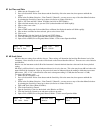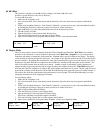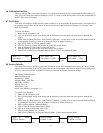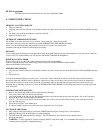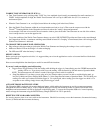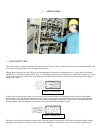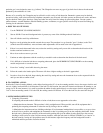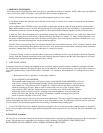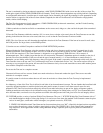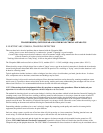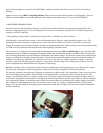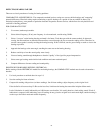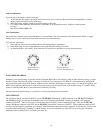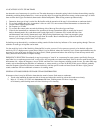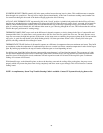19
The test is conducted by placing an ultrasonic transmitter, called TONE GENERATOR, inside (or on one side) of the test item. The
warble pulse-signal from the TONE GENERATOR will instantly "flood" the test item and penetrate any existing leak hole. Depending
on configuration and material, even thin spots in certain metals can be vibrated by the signal. By scanning for sonic penetration on the
exterior surface (or opposite side) of the test item with the Ultraprobe, the leak will be detected. It will be heard as a high pitched
warble, similar to bird chirping.
The Tone Test incorporates two basic components: a TONE GENERATOR (an ultrasonic transmitter) , and the Trisonic Scanning
Module in the Ultraprobe. To conduct the test:
1. Make certain the test item has no fluids or contaminants such as water, mud, sludge, etc., that can block the path of the transmitted
ultrasound.
2. Place the Tone Generator within the container, (if it is a room, door or window to be tested, place the Tone Generator on one side
pointing in the direction of the area to be tested) and close, or seal so that the Tone Generator is enclosed within.
NOTE: The size of the test area will determine the amplitude selection of the Tone Generator. If the item to be tested is small, select
the LOW position. For larger items, use the HIGH position.
3. Scan the test area with the Ultraprobe as outlined in LEAK DETECTION procedure.
When positioning the Tone Generator, place the transducer facing and close to the most crucial test area. If a general area is to be
checked, position the Tone Generator so that it will cover as wide an area as possible by placing it in the "middle" of the test item.
How far will the sound travel? The Tone Generator is designed to cover approximately 4000 cubic feet (120 cu meters) of
uninterrupted space. This is slightly larger than the size of a tractor trailer. Placement is dependent upon such variables as the size of
the leak to be tested, the thickness of the test wall and the type of material tested (i.e. is it sound absorbent or sound reflective?).
Remember, you are dealing with a high frequency, short wave signal. If the sound is expected to travel through a thick wall, place the
Tone Generator close to the test zone, if it is a thin metallic wall, move it farther back and use "low". For uneven surfaces it may be
necessary to use two people. One person will move the Tone Generator slowly close to and around the test areas while another person
scans with the Ultraprobe on the other side.
Do not use the Tone test in a complete vacuum.
Ultrasound will not travel in a vacuum. Sound waves need molecules to vibrate and conduct the signal. There are no moveable
molecules in a complete vacuum.
If a partial vacuum is to be drawn where there are still some air molecules to vibrate, then the Tone Test may be implemented
successfully.
In a laboratory, a form of the Tone Test is utilized in seal leaks of an electron beam microscope. The test chamber has been fitted with
a specially designed transducer to emit the desired tone and a partial vacuum is created. A user then scans all seams for sonic
penetration. The Tone Test has also been effectively utilized to test tanks before they are put on line, piping, refrigerator gaskets,
caulking around doors and windows for air infiltration testing, heat exchangers for leaking tubes, as a Q.C. test for automobile wind
noise and water leaks, on aircraft to test for problems associated with cabin pressure leaks and glove boxes for seal integrity defects.
UE SYSTEMS provides a variety of optional Warble Tone Generators. They are: 1. WTG2SP Warble Pipe Tone Generator with a 1”
male threaded nipple to adapt to various pipe fittings. It is used to test areas where the standard Tone Generators cannot be place
such as in small pipes, sealed tanks or heat exchangers (see optional accessories, WTG-2SP).
2. UFMTG-1991 Multidirectional Tone Generator has four transducers that cover 360
o
. A Specially designed suction cup enables
users to place the unit on a variety of surfaces, metal, plastic or glass. The UFMTG-1991 is used to detect leaks in unusual or
large enclosures. Some applications include: testing bulkheads in ships, expansion joints in power plants and windshields in
automobiles.



